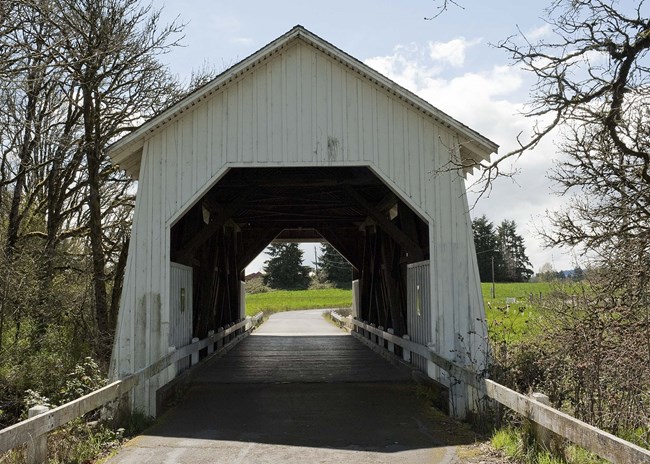
Photograph courtesy of Utah State Historic Preservation Office
Where to Start
The National Register nomination process usually starts with your State Historic Preservation Office* (SHPO). Contact your SHPO or check their web page for National Register information, research materials, and necessary forms to begin the nomination process. If the property is on federal or tribal land, then the process starts with the Federal Preservation Office or Tribal Preservation Office. (More on FPO and TPOs.)
How are Properties Evaluated?
To be considered eligible, a property must meet the National Register Criteria for Evaluation. This involves examining the property’s age, significance, and integrity.
Age and Integrity: Is the property old enough to be considered historic (generally at least 50 years old) and does it still look much the way it did in the past?
Significance: Is the property associated with events, activities, or developments that were important in the past? With the lives of people who were important in the past? With significant architectural history, landscape history, or engineering achievements? Does it have the potential to yield information through archeological investigation about our past?
National Register Listing Process
Nominations can be submitted to your SHPO from property owners, historical societies, preservation organizations, governmental agencies, and other individuals or groups. Official National Register Nomination Forms are downloadable or from your State Historic Preservation Office. National Register Bulletins can also provide guidance on how to document and evaluate certain types of properties. Sample Nominations provide additional useful information.
- The SHPO notifies affected property owners and local governments and solicits public comment. If the owner (or a majority of owners for a district nomination) objects, the property cannot be listed but may be forwarded to the National Park Service for a Determination of Eligibility (DOE).
- Proposed nominations are reviewed by your state’s historic preservation office and the state’s National Register Review Board. The length of the state process varies but will take a minimum of 90 days.
- Complete nominations, with certifying recommendations, are submitted by the state to the National Park Service in Washington, D.C. for final review and listing by the Keeper of the National Register of Historic Places. The National Park Service makes a listing decision within 45 days.
*Note: National Register nominations of Tribal properties start with the Tribal Historic Preservation Officer. National Register nominations of federal properties start with the agency’s Federal Preservation Officer.

Courtesy of the Louisiana State Historic Preservation Office
Results & Owner Information
Listing in the National Register of Historic Places provides formal recognition of a property’s historical, architectural, or archeological significance based on national standards used by every state. Results include:- Becoming part of the National Register Archives, a public, searchable database that provides a wealth of research information
- Encouraging preservation of historic resources by documenting a property’s historic significance
- Providing opportunities for preservation incentives, such as:
- Federal preservation grants for planning and rehabilitation
- Federal investment tax credits
- Preservation easements to nonprofit organizations
- International building code fire and life safety code alternatives
- Possible State tax benefit and grant opportunities. Check with your State Historic Preservation Office for historic property incentives available within your state
- Involvement by the Advisory Council on Historic Preservation when a Federal agency project may affect historic property
- Find out information on the care and maintenance of your historic property through various NPS Preservation Briefs and Tech Notes
- Network with other historic property owners, tour historic areas, or chat with preservationists through Conferences, Workshops, and Preservation Organizations
- Celebrate your listing by ordering a bronze plaque that distinguishes your property as listed in the National Register of Historic Places.

Courtesy of the Oregon State Historic Preservation Office
Listing and Ownership
- Under Federal Law, the listing of a property in the National Register places no restrictions on what a non-federal owner may do with their property up to and including destruction, unless the property is involved in a project that receives Federal assistance, usually funding or licensing/permitting.
- National Register listing does not lead to public acquisition or require public access
- A property will not be listed if, for individual properties, the owner objects, or for districts, a majority of property owners object
- National Register listing does not automatically invoke local historic district zoning or local landmark designation
- The National Register of Historic Places is administered under Federal Regulation 36 CFR 60
- Contact your State Historic Preservation Office (SHPO) for any specific state rules or regulations
Federal Agency Historic Preservation
In conjunction with the Secretary of the Interior, all Federal agencies establish their own historic preservation programs for the identification, evaluation, and protection of historic properties as mandated in Section 110 of the National Historic Preservation Act. These individual agency programs vary greatly in scope, depending on the degree to which the agency owns, controls, or affects historic properties. The NPS Federal Agency Preservation Assistance Program carries out a number of activities to assist Federal agencies in meeting their historic preservation responsibilities. Check with the Federal Preservation Officer (FPO) within a particular federal agency for additional information.Tribal Historic Preservation
The NPS Tribal Preservation Program assists Indian tribes in preserving their historic properties and cultural traditions. Among the responsibilities assumed by these tribes are conducting historic property surveys, maintaining permanent inventories of historic properties, nominating properties to the National Register of Historic Places, and reviewing Federal agency assisted projects. Contact the specific tribal officer from the following list of Tribal Preservation Officers for additional information.Last updated: February 28, 2024
